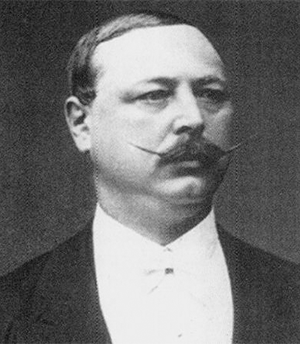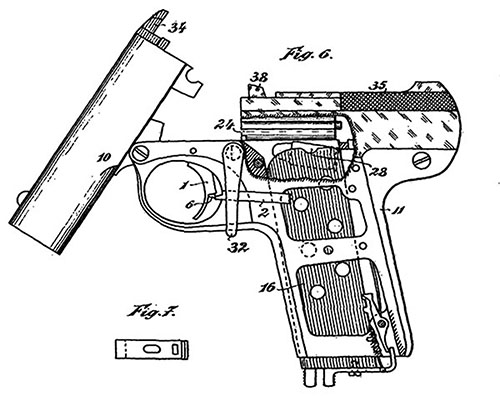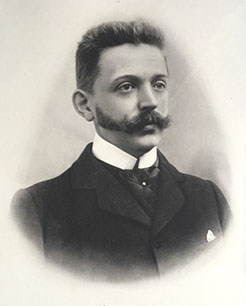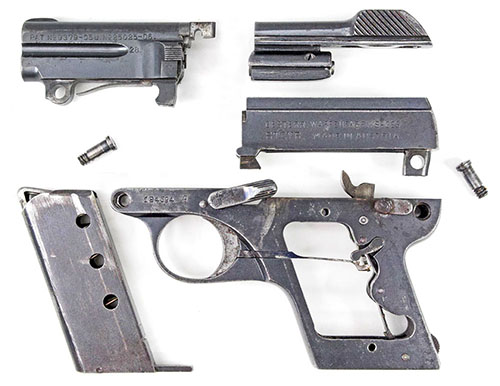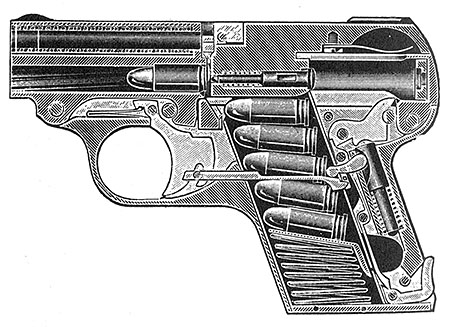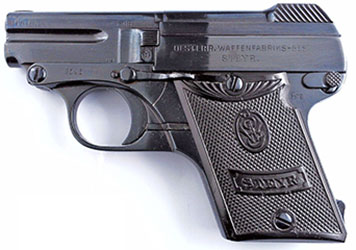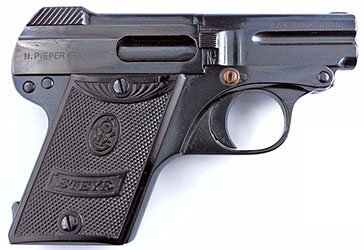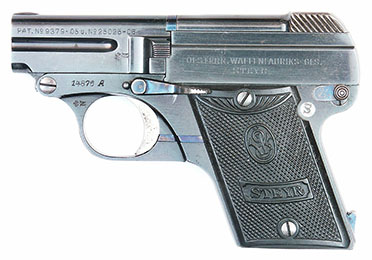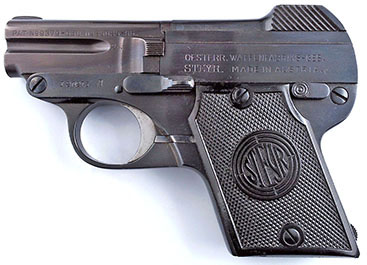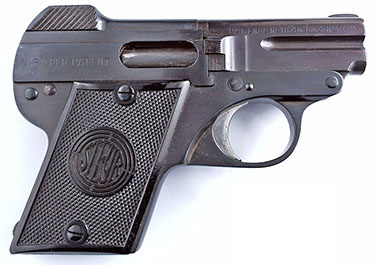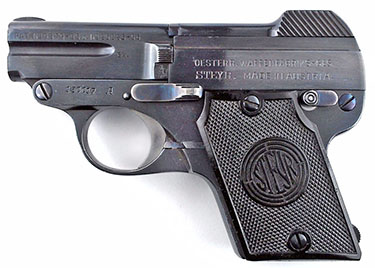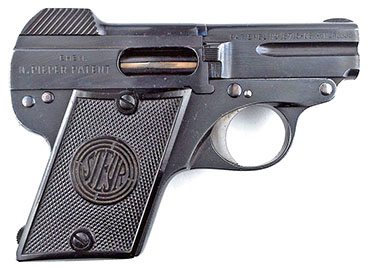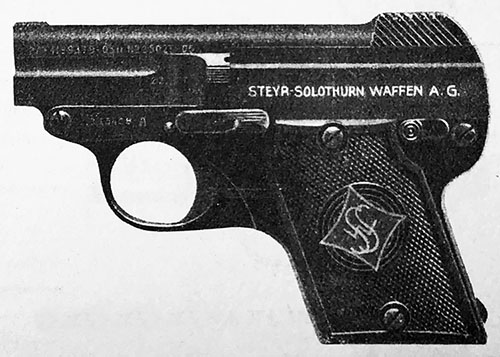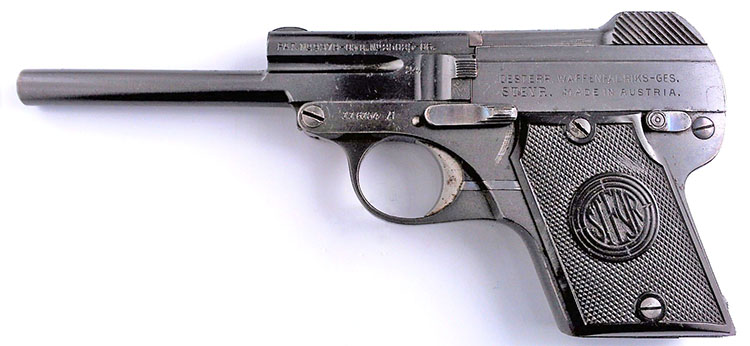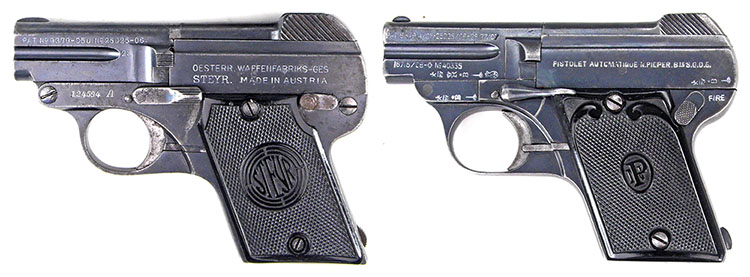 |
|||||||||||||||||||||||||||||||||||||||||||||||||||||||||||||||||||||||||||||||||||||||||||||||||||||||||||||||||||||||||||||||||||||||||||||||||||||||||||||||||||||||||||||||||||||||||||||||||||||||||||||||||||||||||||||||||||||||||||||||||||||||||||||||||||||||
|
The 1909 Steyr Pieper Pistol by Dr. Stefan Klein & Ed Buffaloe
Preliminary Remarks We recommend to collectors the excellent books by Josef Mötz and Joschi Schuy Vom Ursprung der Selbstladepistole (Volume 1) and Weiterentwicklung der Selbstladepistole (Volume 2). This article is based in part on information from these two volumes, which have become a primary resource for collectors of Austrian pistols. The core of this article, however, is our own research into the Belgian weapon designer, Nicolas Pieper, on whose basic design the Steyr Model 1909 is based, as well as studies of examples of all the variants described. Steyr Company History
Josef Werndl (1831-1889), Leopold’s second son, apprenticed as a gunsmith and studied manufacturing techniques in England and Thuringia, Germany. In 1852 he traveled to the United States, where he worked briefly for Colt, Remington, and Pratt & Whitney. He returned to Steyr late in 1853 and rejoined his family business. Leopold Werndl died in 1855 and two of his sons, Josef (1831-1889) and Franz (1833 -1907), took over the company. In 1863 Josef and his Czech friend Karl Holub, a gunsmith who worked for the company, again traveled to the United States, where they spent a year studying the American method for making interchangeable parts with both Colt and Remington. When they returned they began modernizing the Steyr factory. In 1867, Holub developed a means of converting muskets to breech loading rifles and Werndl purchased exclusive manufacturing rights. That same year Josef and his brother Franz established the Josef und Franz Werndl & Company Waffenfabrik und Sägemühle[weapon factory and sawmill]. On 1 August 1869 the company went public to raise money for an expansion needed to meet government contracts for musket conversion. The company name became Österreichische Waffenfabriks Gesellschaft (Austrian arms-manufacturing company),often referred to by the initials ÖEWG or ÖWG, or simply Steyr. In succeeding years, Werndl gathered around him the most talented designers and engineers in Austria, including Karl Holub and the railroad engineer Ferdinand Ritter von Mannlicher. ÖWG Steyr quickly became the most important small arms manufacturer in Europe. Josef Werndl died in 1889, but the company he founded lived on, eventually employing as many as 15,000 workers. The ÖWG became known primarily for its rifle production (Werndl, Kropatschek, Mannlicher, Mannlicher-Schönauer, Schwarzlose MG), and for the production of early automatic pistols designed by Mannlicher. However, due to their complicated mechanisms and large size, these early pistols had a limited clientele. After the turn of the twentieth century, the market for automatic pistols was essentially dominated by the simple but functional designs of John M. Browning. If it wished to compete in the handgun market, Steyr had to find new products. In 1926, the company name was changed to Steyr-Werke A.G. Jean Warnant, Nicolas Pieper, and Steyr Between 1904 and 1907, Jean Warnant, a well-known Belgian firearms designer, was granted several patents for an automatic pistol design in Belgium, Britain, Switzerland, and the United States. Warnant’s Belgian patents (№ 178535, 193286, and 197385) are reflected in his U.S. patent № 889,279, which was filed on 20 May 1906 and granted on 2 June 1908. Warnant's patent claims include various designs in which either the barrel or the breech block can be rotated around an axis, allowing for ease of cleaning and disassembly, as well as for loading and unloading individual cartridges.
Nicolas Pieper, of Liege, Belgium, filed patent applications in 1906 for a magazine release (British Patent № 1906-25025, and U.S. Patent № 859,332). In 1907, he purchased three of Warnant’s patents; and in 1908, he filed patent applications for a transfer bar and release mechanism in both Great Britain and the United States (British patent № 1908-16715 and U.S. patent № 927,070).
Pieper’s second model, the Model of 1908, was made in two versions, both of which featured a release lever on the left side. In the demontant version, the release lever simply disconnected the barrel and upper receiver housing from the grip frame so they could be cleaned. In the basculant version, the release lever allowed the barrel to be tilted up for loading or cleaning. This basculant version, referred to by Mötz and Schuy as the Model P, was the design that Pieper licensed to Steyr. Hence, the bi-weekly magazine Der Waffenschmied reported in December 1908 that Pieper had sold the rights for a pistol to Steyr and that Steyr had begun production of that pistol in the same year. In April 1909, Der Waffenschmied announced the market launch of the Steyr pistol and the first advertisements appeared. The 1913 Stukenbrok catalog lists the Model 1909 in 6.35 mm Browning caliber for 36 marks, and the 7.65 mm for 40 marks; both were comparatively expensive in their day. The Design of the Model 1909 Steyr-Pieper The 1909 Steyr Pieper is a hammer fired unlocked breech design with a barrel that tips upward for loading. The gun breaks down into four main components:
The breech block or bolt depends from the abbreviated slide, both of which reciprocate in the upper receiver housing. The upper receiver housing is mounted on top of the grip frame, and is secured by a single transverse screw on the 6.35mm version.
In the fashion of the Model 1899/1900 FN Browning, the barrel and recoil spring housing of the 1909 Steyr Pieper are machined from a single bar of steel, drilled end-to-end with two parallel holes: the top hole holding the recoil spring and the bottom hole being rifled to form the barrel. The guide rod for the recoil spring has a hook which protrudes from the rear of the spring housing to connect with the breech block. The breech block (or bolt) is attached to a small slide which moves in grooves in the top of the upper receiver housing. The upper receiver housing has an oval ejection port cut into its right side. The barrel and recoil spring housing pivot on a screw at the front of the frame. Beneath the chamber of the barrel is a lug with a half round notch which mates with a half round pin attached to the barrel release lever. Pressing the barrel release lever on the left side of the gun disengages the rear portion of the barrel from the frame so it can be raised for loading.
The rear of the upper receiver housing contains a rubber washer with a hole in the center (where the rear of the firing pin fits), which serves as a stop buffer against recoil from the light-weight slide. This rubber washer has usually disintegrated over the years and is almost never found intact today. This may account for the harsh recoil reported by many shooters. The transfer bar, connecting the trigger to the sear, runs on the left side of the gun. There is no mechanism that positively prevents the gun from firing when the breech is not closed. Instead, a small lever, connected to the hammer, depresses the end of the transfer bar, so it cannot reengage the sear until the hammer is cocked. The magazine holds six cartridges and has three holes on each side for viewing them. A few rare magazines have six staggered viewing holes. The baseplate extends to the rear. There are two slots cut in the back of the magazine which engage the release. The upper slot allows the magazine to be positioned below the point where cartridges can be engaged by the bolt. The tip-up barrel allows cartridges to be loaded and fired one at a time while keeping a full magazine in reserve. Variants of the 6.35 mm Steyr Model 1909 In U.S. collector parlance, this gun is sometimes referred to as the Model 1908, but ÖWG Steyr always referred to it as the Model 1909. Mötz & Schuy distinguish four distinct variations of the Steyr Pieper Model 1909 in 6.35 mm: Preliminary, First, Second, and Third Series. We will follow this systematization. Preliminary Series
The first variant, which Mötz and Schuy refer to as the Preliminary Series, has a slim barrel release lever with a rounded horizontal thumb piece which must be rotated approximately 120° around its axis to release the barrel/spring housing. The barrel/spring housing is not spring-loaded and must be tilted upward by hand. The edge of the frame above the trigger guard curves up slightly and then down to the screw at the front. The safety lever is checkered. In its firing position, it is not aligned parallel with the barrel axis, and swings into a round recess in the rear of the stock. All Pre-Production series pistols feature the word "Fire" instead of "F" next to the safety lever. But care must be taken: if the word “Fire” is visible, the weapon is safe! This does not correspond to normal practice, wherein the visible letter “F” or the word “Fire” would indicate the safety is off. The grasping surface at the rear of the slide has ten angled triangular cut grooves. On the underside of the slide is a flat spring held in place by a screw, referred to by Mötz and Schuy as a “friction spring”, which provides additional friction to slow the slide as it recoils. The breech block, or bolt, depending from the slide, contains the firing pin, but no extractor for the cartridge. The case is blown out of the breech by the detonation force of the cartridge. The left side of the upper receiver housing is marked in upper case characters: OESTERR. WAFFENFABRIKS-GES. The right side of the upper receiver housing is marked: N. PIEPER PATENT The left side of the recoil spring housing is marked with two patent dates: PAT. № 9379-05 u. № 25025-06 Also on the left side we find stamped two digits to indicate the year in which the gun was manufactured. We should note that such a date on Austrian guns is usually the year in which the gun was proofed, but Mötz and Schuy explain that, due to the quantity of guns being manufactured, the barrels were dated but proofing took place later. Guns intended for export usually required proofing in the country in which they were to be sold and so were not proofed at the factory. The right side of the recoil spring housing is marked with the Swiss cross and an additional patent date: PAT.+ № 40335 The patents referenced are as follows:
Grip stocks are of checked hard rubber with the ÖWG monogram in an oval near the top and the word STEYR in a curved banner beneath it. Production began in 1908. According to proof house records, 55 guns were proofed in Vienna in 1908. Mötz and Schuy estimate that approximately 5000 of the Preliminary Series guns were made; however, no three digit serial numbers have been identified. The lowest serial number they have documented is 1288 and the highest is 5305; we have identified one with the serial number 5454. Mötz and Schuy argue that the Preliminary Series had its own serial number sequence. First Series
The First Series runs from serial number 5001A to approximately 42000A. It is externally almost identical to the Preliminary Series, but is easily identified by the suffix "A" after the serial number. The barrel release lever has a slightly different shape and only moves in an arc of about 30°; it is now spring loaded, so it springs back to its original position after being actuated. A V-shaped leaf spring is added to the bottom of the barrel, which forces the barrel upward as soon as the release lever is depressed. The safety lever now has concentric circles instead of checkering. The word “Fire” is removed; there is, correctly, the letter “S”, which is covered by the safety lever when the gun is ready to fire. The grasping surface of the slide is 1 mm shorter and has only nine angled grooves. Production of the First Series likely began early in 1909. The first manual, which appeared in May 1909, shows a First Series gun with the serial number 5001A. All early advertisements we have been able to locate show the First Series gun with sprung barrel. Second Series There were further refinements in the Second Series, which extends from approximately serial number 42001A to 129500A, with production beginning sometime in 1912, per Mötz and Schuy. The upward curve on the lower edge of the frame, above the trigger guard, is eliminated, so the line flows straight from the upper edge of the trigger to the screw upon which the barrel rotates. The barrel release lever is made thicker and shorter, and its spring is stronger than on the First Series. The release lever is no longer offset at the rear to clear the stock; instead, there is a cutout in the corner of the stock to allow the lever to rotate flush with the surface of the frame. The lever may have been shortened to help prevent accidental opening of the breech.
The safety lever now pivots through 180°. The stock is more generously recessed to allow the safety lever to point toward the front when the gun is ready to fire. In addition, the weight of the slide and breech block is increased by 7 grams to 53 grams. The grasping surface of the slide is slightly higher overall; in addition, the grip spur is slightly deeper. The total weight of the weapon is increased by about 20 grams to 350 grams. The friction leaf spring on the underside of the breech block is extended slightly and is secured using a clamp instead of the screw used in the Preliminary Series and First Series. The shape of the magazine release is changed slightly; it protrudes less but is not as easily operated. The only change to external markings is that the right side of the recoil spring housing is marked with two patent dates, instead of only one. An additional British patent, № 16715 of 1908, is added, so the inscription reads: PAT. ENGL № 16715-08. + № 40335 At least one pistol observed (serial number 42883A) retains the early magazine release, early barrel release, and curved line above the trigger, but has the new patent date, new safety lever, and modified left grip stock. It may be considered transitional, having some characteristics of both the First and Second Series. There are likely a few more weapons with similar features. Despite the cut corners on the left stock, the stock markings remain the same as on earlier guns until the end of World War I. Then we begin to see wooden stocks with rough checkering, after which a new stock design appears in checked hard rubber with the word Steyr in a stylized target in the center. Beginning in 1922, the inscription on the left side of the upper receiver housing is changed, with the addition of MADE IN AUSTRIA, indicating a greater effort to market the gun outside the German speaking world: OESTERR. WAFFENFABRIKS-GES. Because patent protection was expiring around 1930, the letters EHEM (meaning “former”) were added to the inscription on the right side of the upper receiver housing: EHEM. Third Series In the Third Series, which appeared in 1931, running from approximately serial number 129160A to 131000A, an extractor is added to the breech block. The extractor runs the entire length of the breech block and is inserted into a dovetail from behind. There is a recess for the extractor on the rear face of the barrel housing. The Third Series is the most scarce. Our current estimate is that only around 1850 pistols were made before production ended.
In the WUM catalog of 1932, the two Steyr pistols illustrated feature the inscription: STEYR-SOLOTHURN WAFFEN A.G. The grip panels of this pistol show an SSW monogram surrounded by the diamond logo of the German Rheinmetall company which is set over the circular stylized target of the Steyr company. Steyr-Solothurn Waffen was a Swiss company, owned by Rheinmetall of Germany, which partnered with Steyr-Werke to produce weapons for Rheinmetall and evade treaty restrictions placed on German weapon makers after WWI. We have never observed a Steyr pistol with such markings. Mötz & Schuy state: “This inscription and the grip design with the Steyr-Solothurn Waffen AG logo probably never existed. It is most likely a retouched image for advertising purposes.”
Long Barrel Pistols Due to Austro-Hungarian gun legislation, we find Steyr pistols with a long barrel, extending the overall length of the weapon to 18 centimeters (7 inches). By law, shorter pistols required a permit from the police authorities in order to buy them, and an additional permit if one wished to carry them. For those who did not wish to apply for a license, Steyr offered a long version of the gun which was legal to own without a license. However, the law and it's interpretation changed several times, thus we find both early and late long barrel Steyr pistols. Long barrel guns are also known in 7.65 mm, but are much more scarce. For more information see: 1909 Steyr with Long Barrel.
Total Production of the 6.35 mm Mötz and Schuy estimate a total production of about 135,800 pistols, assuming Preliminary Series pistols had a separate serial number range. 1909 Steyr and the 1909 Pieper Model D The Steyr Model 1909 appeared in the same year as Nicolas Pieper’s Model D. The two guns are internally and externally very similar, though Pieper’s Model D does not feature a tilt barrel. Michel Druart has suggested that Steyr may have made some of Pieper’s early guns. We were able to give both the Model D and the 1909 Steyr a close examination, and concluded that there are enough minor differences in the pistols that it is very unlikely they were both made by Steyr. They are clearly based on the same patents, but the implementation is different. Perhaps Steyr did make Pieper’s early guns, but probably not the Model D.
|
|||||||||||||||||||||||||||||||||||||||||||||||||||||||||||||||||||||||||||||||||||||||||||||||||||||||||||||||||||||||||||||||||||||||||||||||||||||||||||||||||||||||||||||||||||||||||||||||||||||||||||||||||||||||||||||||||||||||||||||||||||||||||||||||||||||||
|
|||||||||||||||||||||||||||||||||||||||||||||||||||||||||||||||||||||||||||||||||||||||||||||||||||||||||||||||||||||||||||||||||||||||||||||||||||||||||||||||||||||||||||||||||||||||||||||||||||||||||||||||||||||||||||||||||||||||||||||||||||||||||||||||||||||||
|
Copyright 2009-2024 by Dr. Stefan Klein and Ed Buffaloe. All rights reserved. |
|||||||||||||||||||||||||||||||||||||||||||||||||||||||||||||||||||||||||||||||||||||||||||||||||||||||||||||||||||||||||||||||||||||||||||||||||||||||||||||||||||||||||||||||||||||||||||||||||||||||||||||||||||||||||||||||||||||||||||||||||||||||||||||||||||||||
|
|
|||||||||||||||||||||||||||||||||||||||||||||||||||||||||||||||||||||||||||||||||||||||||||||||||||||||||||||||||||||||||||||||||||||||||||||||||||||||||||||||||||||||||||||||||||||||||||||||||||||||||||||||||||||||||||||||||||||||||||||||||||||||||||||||||||||||
